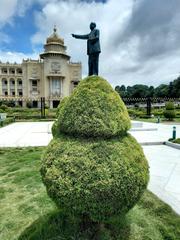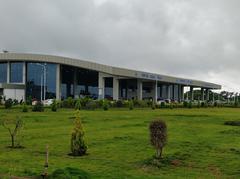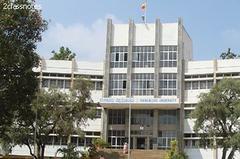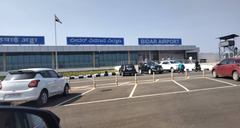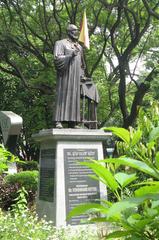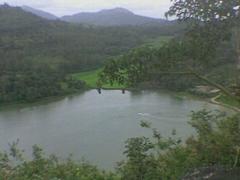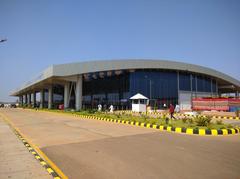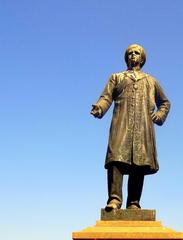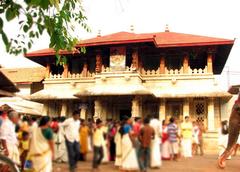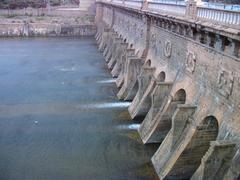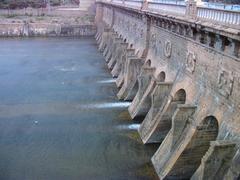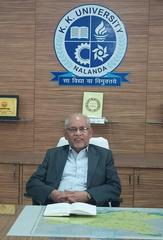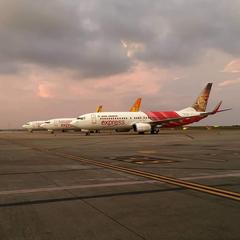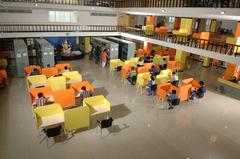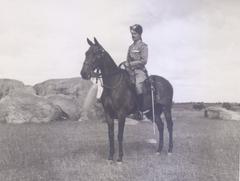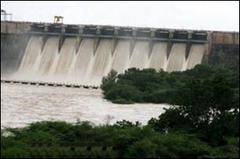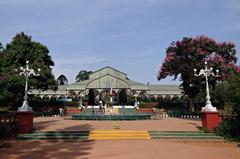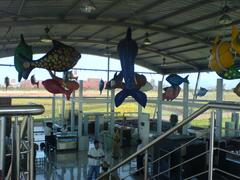
Kotilingeshwara Temple Visiting Hours, Tickets, and Travel Guide | Karnataka, India
Date: 04/07/2025
Introduction
Nestled in Kammasandra village, Kolar district, Karnataka, the Kotilingeshwara Temple stands as a modern marvel of Shaivite devotion, renowned for its ambitious goal to house one crore (10 million) Shiva lingas. Established in 1980 under the vision of Swami Sambha Shiva Murthy, the temple has become an epicenter for spiritual pilgrimage, blending deep-rooted mythological traditions with vibrant contemporary festivals and architectural grandeur.
The temple’s centerpiece—a towering 108-foot (33-meter) Shiva linga, the tallest in Asia—dominates a sprawling campus of 13 to 15 acres. Adjacent to it is the imposing 11-meter tall Nandi statue, both symbols of unwavering faith and divine power. The temple complex is home to more than 90 lakh lingas of varying sizes, meticulously arranged, creating a mesmerizing sea of lingas that encapsulates the collective devotion of millions.
Kotilingeshwara Temple’s significance extends beyond its architecture. Rich legends, such as the tale of Bhakta Manjunatha and the myth of installing a crore lingas to atone for sins, infuse the site with mythological depth. The temple is also a hub for community service, offering rest houses, free meals, wheelchair accessibility, and hosting mass marriages, making it a beacon of inclusivity.
Strategically located near Bangalore and Kolar, the temple is easily accessible and close to other heritage sites like Bhoga Nandeeshwara Temple and Kolar Gold Fields, enriching the cultural pilgrimage experience. This comprehensive guide covers Kotilingeshwara Temple’s history, spiritual significance, architectural highlights, visiting hours, ticketing, travel tips, major festivals, and practical visitor information to help you plan a meaningful visit. (Hindutsav; Karnataka.com; Templeinkarnataka.com; Mystreal)
Table of Contents
- Introduction
- History and Legends
- Spiritual and Religious Significance
- Architectural Highlights
- Visitor Information
- Major Festivals and Rituals
- Facilities and Accessibility
- Travel Tips
- Nearby Attractions
- Frequently Asked Questions
- Visuals and Resources
- Conclusion
- References
History and Legends
Origins and Development
While the Kotilingeshwara Temple is a relatively modern establishment, its roots can be traced to ancient traditions. The temple’s name derives from the Kannada words “Koti” (crore), “Linga” (the iconic representation of Lord Shiva), and “Eshwara” (another name for Shiva), reflecting the mission to install one crore lingas (Hindutsav).
Swami Sambha Shiva Murthy established the temple in 1980. The first linga was installed that year, and the number has since grown to over 90 lakh, with the goal of reaching a crore (Karnataka.com).
Ancient References & Legends
Local lore suggests that the site was a place of worship as far back as the 8th century CE, during the Rashtrakuta Empire, and was associated with Lord Manjunatha. Legends attribute the inspiration for the temple to Bhakta Manjunatha, whose transformation from atheist to devotee led him to vow to install ten million lingas as penance (CityBit).
The temple’s mythos is further enriched by tales of Sage Gautama, the Chola dynasty, and self-manifested lingas, cementing its status as a site of deep spiritual resonance (Famous Temples of India).
Spiritual and Religious Significance
Symbolism
“Kotilingeshwara” stands for the aspiration to install one crore lingas, representing the collective faith and devotion of millions. The Shiva linga itself is a symbol of the formless, cosmic pillar of creation in Hinduism, and linga installation is believed to bring blessings and spiritual merit (Kotilingeshwara Temple Guide).
Main Deities and Shrines
The temple’s colossal 108-foot Shiva linga and 11-meter Nandi are focal points for worship. The complex also houses eleven other shrines dedicated to deities such as Lord Vishnu, Lord Brahma, Lord Panduranga, Lord Panchamukha Ganapati, Goddess Annapurneshwari, and Lord Venkataramani Swamy (Kotilingeshwara Temple Deities).
Rituals and Offerings
Devotees can perform “Linga Pratishta”—the installation of a personal linga—starting at INR 6,000, with the linga inscribed with the devotee’s name. Daily rituals include abhishekam (ritual bathing), aarti, and Vedic chanting. Mondays and festival days feature additional ceremonies (Kotilingeshwara Temple Rituals).
Architectural Highlights
Main Linga and Nandi
The world’s tallest Shiva linga (108 feet) is constructed from reinforced concrete and painted in traditional hues. It is accompanied by an 11-meter Nandi, both serving as iconic symbols and central points for meditation and worship (templeinkarnataka.com; thedilli.in).
Sea of Shivalingas
Over 90 lakh lingas, ranging from a few inches to several feet, are installed throughout the 13-15 acre campus, many bearing donor names (templeinkarnataka.com). This participatory landscape is visually and spiritually striking.
Subsidiary Shrines
There are 11 smaller temples in Dravidian style, dedicated to various deities, enabling devotees to perform multi-deity worship in a single visit (thedilli.in).
Sacred Trees
The Nagalinga and Cannon Ball trees are believed to fulfill wishes, especially for unmarried women, adding a unique botanical dimension to the site (thedilli.in).
Visitor Information
Visiting Hours
- General Hours: 6:00 AM to 9:30 PM daily (Templestime; Gotirupati)
- Darshan Timings: 6:00 AM–12:30 PM and 5:00 PM–8:00 PM
- Ticket Counter Opens: 7:00 AM
Entry Fees and Tickets
- Entry Fee: INR 20 per person
- Camera Fee: INR 100
- Linga Installation: Starts at INR 6,000
Dress Code
Traditional, modest attire is encouraged:
- Men: Dhoti, pyjama with upper garments, or trousers
- Women: Saree, half-saree, or churidar with dupatta (Mandirtimings)
Accessibility
- Wheelchair-friendly pathways and ramps
- Assistance available for differently-abled visitors
- Large parking area (INR 30 per vehicle)
- Rest houses and meditation halls available (thedilli.in)
Facilities
- Dining: Free meals (Anna Prasadam) served 12:30 PM–3:30 PM and 7:00 PM–8:00 PM
- Rest Houses: Basic accommodation on campus
- Restrooms and Drinking Water: Available throughout the complex
- Shops: Local eateries and souvenir shops nearby
Major Festivals and Rituals
Maha Shivaratri
The most significant festival, held annually in February/March, features night-long vigils, special abhishekams, cultural programs, and mass prayers. The temple is beautifully decorated and sees its highest footfall (Mystreal; Gotirupati).
Karthika Masa
Observed in November, Karthika Masa is marked by lamp-lighting and prayers for blessings, with Monday rituals attracting large crowds (Gotirupati).
Navaratri
The temple honors Navaratri with special poojas, particularly in its shrines dedicated to goddesses (Gotirupati).
Daily Rituals
Daily abhishekam and aarti are performed at 6:00 AM and 6:00 PM, with Mondays holding special significance (Pilgrimaide).
Unique Traditions
- Mass Marriages: Free mass marriages are hosted weekly, supporting community welfare (thedilli.in).
- Linga Installation: Visitors can participate in ongoing linga installations, creating a personal spiritual legacy.
Travel Tips
- Best Time to Visit: October to March for pleasant weather; early mornings and weekdays for fewer crowds
- Peak Days: Mondays and during Maha Shivaratri
- How to Reach:
- By Road: 80-100 km from Bangalore; regular buses and taxis available (thedilli.in)
- By Train: Nearest stations are Bangarapet (15 km) and Kolar (6 km)
- By Air: Kempegowda International Airport, Bangalore (70 km)
- Footwear: Remove shoes before entering the main temple; racks provided
- Hydration: Carry water, especially in summer
- Respect Customs: Silence in sanctums, no flash photography during rituals
Nearby Attractions
- Bhoga Nandeeshwara Temple: Ancient shrine near Nandi Hills
- Antaragange: Sacred hill with caves and trekking
- Kolar Gold Fields: Heritage mining site
- Mulbagal: Town with historic temples and scenic beauty
Visuals and Interactive Resources
Alt tags optimize for keywords like “Kotilingeshwara visiting hours” and “Kotilingeshwara tickets.”
Frequently Asked Questions (FAQs)
Q1: What are the Kotilingeshwara Temple visiting hours?
A1: 6:00 AM to 9:30 PM daily; darshan from 6:00 AM–12:30 PM and 5:00 PM–8:00 PM.
Q2: What is the entry fee?
A2: INR 20 per person; camera fee is INR 100.
Q3: Can I install a Shiva linga?
A3: Yes, installation starts at INR 6,000. Book at the temple office.
Q4: Is the temple accessible for differently-abled visitors?
A4: Yes, wheelchair-friendly pathways and facilities are available.
Q5: How do I reach the temple from Bangalore?
A5: By car, bus, or train to Kolar or Bangarapet, then local transport.
Q6: Are guided tours available?
A6: Volunteers provide information; formal tours are limited.
Conclusion
Kotilingeshwara Temple is not just a monumental center of Shiva worship, but also a living testament to the enduring power of collective faith, community spirit, and architectural vision. With its awe-inspiring linga, immersive rituals, and thoughtful visitor facilities, the temple promises a spiritually enriching and culturally rewarding experience. Plan your visit with awareness of timings, ticketing, and travel logistics for a seamless pilgrimage or heritage excursion.
For the latest updates, festival announcements, and travel resources, download the Audiala app and follow our social media channels. Explore more about Karnataka’s sacred heritage with our related guides.
References
- Kotilingeshwara Temple: History, Legends, Visiting Hours & Travel Tips, Hindutsav
- Kotilingeshwara Temple Overview, Karnataka.com
- Kotilingeshwara Temple Guide, Templeinkarnataka.com
- Kotilingeshwara Temple Pilgrimage and Rituals, Mystreal
- Kotilingeshwara Temple Visiting Hours and Tickets, Gotirupati



